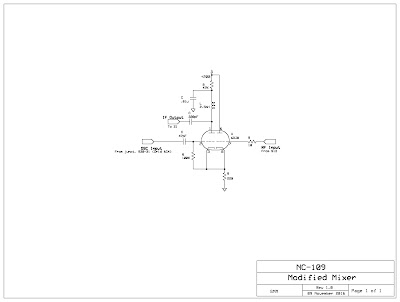Looking to add a few dB to the QRP output of my HB rigs, I stumbled across a number of these Chinese Irf530 amplifiers on Ebay at very reasonable prices - generally $15, including shipping. Not being one to pass up a potential bargain, I popped for one and it arrived today. Above shows the contents of the package emptied into one of the XYL's best cake tins. She'll never miss it. Why a cake pan when I have a nice, white, melamine surface? Because these parts are
small and have an annoying tendency to pop free from the tweezers or forceps at the worst possible time, and a cake tin works perfectly to constrain those parts that attempt to go rogue.
Because the parts are so small and my eyes are not a sharp as they once were, I made use of the camera in my tablet to help identify the various resistors:
While it may be difficult to see here, I was able to clearly read the lettering on the part during assembly.
It's worth noting that there are a couple of different versions of this kit in circulation (v303 and v306), and the documentation provided (for download) from the vendors suffers from poor translation. An improved english manual is available for v303, but it proved of limited value because, while the kits are very similar, there are some significant differences in both the design and parts used. Best to suffer aong with the Chinglish instructions - which is really nothing more than a parts list (in .xls format), pictures of the top and bottom of the board, and instructions (again in Chinglish) for winding the three transformers and RF-choke. These were adequate - I was able to understand what they were saying, but I'm at leat an intermediate-level builder and have wound countless ferrite transformers and chokes. Still, it's hardly rocket science.
So, in constructing the board, I follow a practice of installing the small SMD parts first - it's easier to do so now than after adding larger parts that take the board from the 2nd to 3rd dimension. With this one, I started with the .01 capacitors, then the .1 and then the couple of 100 pF caps. The large electrolytic and mica can wait.
After installing the caps, I moved on into the realm of resistance, soldering all the SMD resistors to the board.
It should be noted that, while the capacitor values are unmarked, when you inventory the parts, it'll be apparent which are which based on the quatities included with the kit. The resistors ARE marked - not long ago, I could read the markings with the naked eye, but over the past 10 years, this has become challenging and I've had to resort to magnification.
Once the SMD stuff is installed, you can move on to the larger parts. Easiest was to first install the two pots, and, while you're at it, set the center terminal of each to the ground side. This way, the '530s will be turned-off when you fire it up, reducing the chances of accidentally frapping the silicon.
After this, I installed the two molded chokes and the 2 large 22 Ohm resistors, leaving enough wiggle room in the lead to solder in the '530s when the time comes.
I wound the transformers next. The instruction sheets (downloaded) caution that the edges of the cores are sharp and should be relieved to prevent nicking the wire's insulation. They mention scraping the edges with needlenose pliers, but I find it easier to chamfer the edges uing various sizes of phillips screwdrivers.
There's nothing tricky about winding these - a single winding is nothing more than passing the wire through both holes in the binocular cores, so do what it says and you'll be fine. T3 has a tapped primary - put two one-turn windings through the core, twist the opposite ends of each winding togeter to form the center tap. Not a big deal.
I still need to prepare my heat sink, so I left the board at this point before knocking-off for the night:
It took only a couple of hours to get to this point, and I've probably got about that much left in prepping the heat-sink, wiring up the power supply, low-pass filter and T/R relay. With any luck, I'll be able to bang that out tomorrow and get on with some testing! Wish me luck.
73 - Steve
























